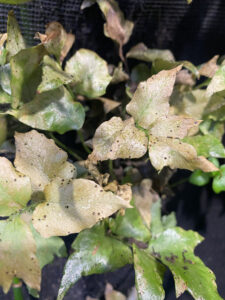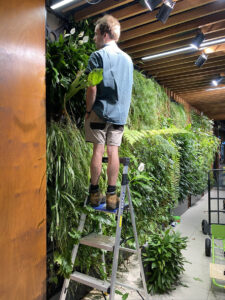
Plants and insects can coexist in indoor spaces with the right mix
By Michael Casey
The rise in interest in interior plantscaping, along with vertical gardens and other forms of interior plant layouts, is being matched with the results of the associated benefits. These include providing clean pollution-free filtered air and cooler environments, along with connecting people to nature.
As these vast amounts of different plant species and varieties move into their new environments, they are also forming a web of foliage based on the nature of the dense planting that inevitably takes place with vertical gardens. With this, insect life and other forms are introduced, which adds to the intricate web of nature and increases the biodiversity that we would expect from natural settings. However, what is the impact when indoor and confined planting spaces provide the perfect climate zones for insects to colonise, multiply or in some cases, destroy the cherished foliage and flowers?
Indoor plantscapes, including vertical walls, can flourish in interior environments when installed correctly by designers and expert installers. This includes correct lighting, circulation of air and plant selection, all of which add to the aesthetic and overall success of the landscape. While the installation needs to be executed correctly, any changes or tweaks made, however seemingly insignificant, can have a detrimental effect on plantscapes and disrupt the natural equilibrium.
Insect populations that are damaging and affect the health of plants, and general living conditions of people and pets, need to be treated and controlled, especially when located in sensitive spaces. Places such as offices, schools, childcare centres, nursing homes, and rehabilitation centres are all environments that require thoughtful and calculated solutions for controlling insect life.
Outside of chemical control, which should be avoided at all costs, there are methods to effectively and efficiently control/manage outbreaks that will not impact the health of building occupants, especially those that are most vulnerable. The use of integrated pest management (IPM) techniques combines the use of biological and cultural practices to control pests, including the introduction of natural predators or parasites. Chemicals should only be introduced if pests cannot be controlled naturally.

A basic understanding of insect life cycles will assist in improving the chances of controlling insects. It is not viable to seek to control an insect population that is at the end of its life cycle, nor is it worth controlling if it has been identified that there is an insect species inside the planted environment that can achieve the desired outcome for us. Beloved lady bugs, for example, are highly effective in assisting in the natural clean-up of aphids. Therefore, knowledge of insect species and their life cycles will avoid wiping out all species, along with valuable time and resources.
Plant knowledge is a key capability to have to accurately specify plants for an interior environment. I have seen first-hand, through the inappropriate selection of plants for green walls and interior landscapes, where this has invited and harboured pest and fungal issues, or the plants simply fail to flourish and perform as intended. Some plants excrete a lot of sap when pruned causing a buildup on the leaves of other plants which can lead to fungal issues, which may be hard to control, or provides a food source for insects. Other plants are just not suited to growing indoors or in poor light conditions. A weak plant can be more susceptible to being targeted by insects.
Sound plant knowledge also allows for the right choice of species that grow well in spaces such as green walls and hanging displays that may otherwise be very unnatural to the plant. Plants growing too dense, or smothering other plants, can also lead to poor air circulation or provides safe protected zones for insects to breed which leads to difficulties in locating or controlling these pests.
This knowledge can also extend to determining the plant nutrient requirements for optimum growth and health. The fertilisation of plants inside buildings and on walls can be time consuming, and in the case of vertical walls, will require the nutrient solution to be supplied by a mechanical aid in the form of a fertigation unit. Understanding the correct doses and the operational requirements will ensure over or under fertilising does not occur. Introducing companion planting to the plant palette can potentially assist in attracting beneficial insects to help control the more destructive ones. This may also become a solution to a known and ongoing issue where other methods of control have been exhausted.
When it comes to the surrounds in which the plants will grow, a thorough understanding of how to control the environment the plants are living in will ensure optimum health. Lighting ensures plants receive what they would ordinarily receive if living outside. Controlling ambient interior temperatures and air circulation will ensure warm and humid environments are controlled or limited. Humid microclimates, especially with little or no air movement, can be a haven for insects to breed and multiply. Densely planted green walls can be a recipe for disaster, as walls are typically maintained by maintenance contractors only monthly or bimonthly. Long periods between maintenance sessions enables insects to readily colonise an area which can make control exceedingly difficult.
Insects, whether they are a classified friend or foe, can cause problems when the environmental equilibrium becomes unsettled. When managed appropriately, the balance of friendly insects can assist in controlling foe insects before plants are damaged, or in some cases, destroyed. However, equipping yourself with the knowledge on when to intervene, and applying new methods of controlling the balance, only takes the time to do the research and then to apply the knowledge. Maintenance and management of plant health, good horticultural knowledge, and the control of pests and diseases will help with an integrated approach to preventing and treating outbreaks.
Michael Casey Director of Evergreen Infrastructure
and MJC Horticulture
Advisor to the green infrastructure industry.
E: michael@evergreeninfrastructure.com.au
